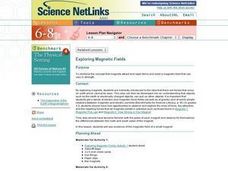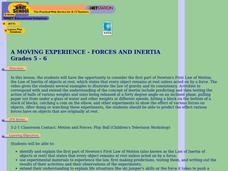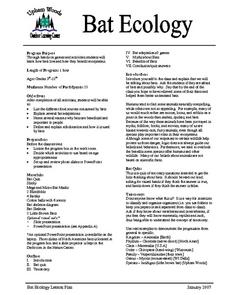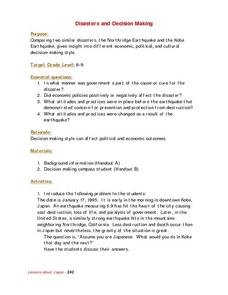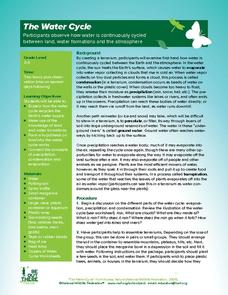Curated OER
A Different Point of View
Fourth graders imagine what North Carolina looks like from the air. Looking at a map, they list the different kinds of views we might find, (i.e., beach, mountains, cities, farms, etc.) then attempt to draw their own version of a map.
Curated OER
Sculptures from the Skies
Fourth graders research the design of the aircraft used by the Wright Brothers at Kitty Hawk. They design a sculpture of aircraft using recycled materials.
Curated OER
New Perspectives
Eighth graders imagine they are getting ready to "take off." They may imagine themselves in any type of aircraft or spaceship. They may then sketch themselves as passengers anticipating this moment.
Curated OER
Circle of Pong
Learners, in groups, use given materials to devise a way to deposit a ping-pong ball into a paper cup that is located in the middle of a 6-foot diameter circle, while standing outside the circle.
Curated OER
A Trip To Outer Space: Planet Exchange
Students examine the different planets in outer space. Each class studies a different planet and creates a scavenger hunt for the other classes to explore that planet.
Curated OER
Exploring Magnetic Fields
Students explore the concept that magnets attract and repel items and exert a magnetic field that can vary in strength. They see evidence of the magnetic field of a small magnet. They see that there are forces on earth which cannot be seen.
Curated OER
Sediment Sleuths
Students classify sediments based on their physical characteristics, such as size, shape and color. They identify and describe rocks and minerals that are common to their region of the state.
Curated OER
Mass
Students determine how mass is a property of an object that can be measured, and examine how size affects mass. They work with balances and determine what units of measurement are associated with mass. Finally, they determine the...
Curated OER
Exploring Magnetic Fields
Students develop the concept that magnets attract and repel items and exert a magnetic field that can vary in strength.
Curated OER
A Moving Experience - Forces and Inertia
Learners view a video and complete corresponding activities to observe inertia. They observe and predict the effect various forces have on objects.
Curated OER
Plant and Animal Cells - Are they Different?
Learners observe the similarities and differences between plant and animal cells. In this cell activity, students use microscopes to observe self prepared slides of animal and plant cells.
Curated OER
Bat Ecology
Students, through hands on games and activities, discover how bats live and how bats benefit ecosystems. They play a game designed to show them how echolocation works and another to show how mother bats locate their young through their...
Dick Blick Art Materials
Insoluble Paintings
Insolubility and density? Yup, it's art class, of course. To create insoluble paintings that continually move and change, kids mix water-based paint with mineral oil and seal the mixture in laminating pouches.
Curated OER
Free Up the Ketchup!
Learners, in teams, use given materials and their knowledge of Newton's First Law to create a device that will remove a sticky ping pong ball from a 16-oz. cup (which represents ketchup stuck in a bottle.)
Curated OER
A Moving Experience - Forces and Inertia
Young scholars consider the first part of Newton's First Law of Motion, the Law of Inertia of objects at rest, which states that every object remains at rest unless acted on by a force. They perform hands-on experiments which demonstrate...
Curated OER
Disasters and Decision Making
Students compare the Northridge and Kobe earthquake. In groups, they identify the economic, political and culture decisions that were made according to the various cultures. They answer discussion questions and share their answers with...
Curated OER
Force & Motion
Third graders are introduced to the concepts of force and motion. In groups, they travel between stations to analyze the effect of force and motion on various objects. They research how various careers use these concepts as well.
Curated OER
The Water Cycle
Students are introduced to the components and importance of the water cycle. They are shown how groundwater moves using a model. Students list 9 places on earth where water is found. They define the terms cycle and water cycle.
Curated OER
Discovering Math: Concepts in Algebra
Young scholars learn that speed is a function of time and distance, a quadratic equation can be used to figure out the path of fireworks, a photographer can use Algebra to figure out how many rolls he can afford if he needs twice as much...
Curated OER
Crashed on the Moon
Students compare and contrast the environments of the moon and the earth. They discover how the differences might change one's daily activities.
Curated OER
Don't Crack Humpty
Students investigate the engineering design process and the relationship between distance, time, and speed. Using a generic car base, small groups design a device that will protect an egg on or in the car as it is rolled down a ramp at...
Aiken County Public Schools
Claymation in the Classroom
Students design an appropriate and usable storyboard and then create a claymation video. They take digital photographs frame by frame, then assemble the stop-motion movie using video software.
Curated OER
Salinity
Learners define and discuss salinity, conduct classroom experiment to determine salinity of water sample by using hydrometer, record predictions, and demonstrate understanding of how salinity influences object's ability to float in water.





